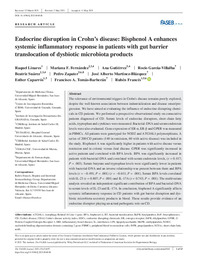Por favor, use este identificador para citar o enlazar este ítem:
https://hdl.handle.net/11000/31113Registro completo de metadatos
| Campo DC | Valor | Lengua/Idioma |
|---|---|---|
| dc.contributor.author | Linares, Raquel | - |
| dc.contributor.author | Fernández, Mariana F. | - |
| dc.contributor.author | Gutiérrez, Ana | - |
| dc.contributor.author | García-Villalba, Rocío | - |
| dc.contributor.author | Suárez, Beatriz | - |
| dc.contributor.author | Martínez-Blázquez, José Alberto | - |
| dc.contributor.author | Caparrós, Esther | - |
| dc.contributor.author | Tomás-Barberán, Francisco A. | - |
| dc.contributor.author | Francés, Rubén | - |
| dc.contributor.other | Departamentos de la UMH::Medicina Clínica | es_ES |
| dc.date.accessioned | 2024-02-05T18:06:56Z | - |
| dc.date.available | 2024-02-05T18:06:56Z | - |
| dc.date.created | 2021 | - |
| dc.identifier.citation | FASEB Journal . 2021 Jul;35(7):e21697 | es_ES |
| dc.identifier.issn | 1530-6860 | - |
| dc.identifier.issn | 0892-6638 | - |
| dc.identifier.uri | https://hdl.handle.net/11000/31113 | - |
| dc.description.abstract | The relevance of environmental triggers in Crohn's disease remains poorly explored, despite the well-known association between industrialization and disease onset/progression. We have aimed at evaluating the influence of endocrine disrupting chemicals in CD patients. We performed a prospective observational study on consecutive patients diagnosed of CD. Serum levels of endocrine disruptors, short-chain fatty acids, tryptophan and cytokines were measured. Bacterial-DNA and serum endotoxin levels were also evaluated. Gene expression of ER-α, ER-β and GPER was measured in PBMCs. All patients were genotyped for NOD2 and ATG16L1 polymorphisms. A series of 200 CD patients (140 in remission, 60 with active disease) was included in the study. Bisphenol A was significantly higher in patients with active disease versus remission and in colonic versus ileal disease. GPER was significantly increased in active patients and correlated with BPA levels. BPA was significantly increased in patients with bacterial-DNA and correlated with serum endotoxin levels, (r = 0.417; P = .003). Serum butyrate and tryptophan levels were significantly lower in patients with bacterial-DNA and an inverse relationship was present between them and BPA levels (r = -0.491; P = .001) (r = -0.611; P = .001). Serum BPA levels correlated with IL-23 (r = 0.807; P = .001) and IL-17A (r = 0.743; P = .001). The multivariate analysis revealed an independent significant contribution of BPA and bacterial-DNA to serum levels of IL-23 and IL-17A. In conclusion, bisphenol A significantly affects systemic inflammatory response in CD patients with gut barrier disruption and dysbiotic microbiota secretory products in blood. These results provide evidence of an endocrine disruptor playing an actual pathogenic role on CD. | es_ES |
| dc.format | application/pdf | es_ES |
| dc.format.extent | 13 | es_ES |
| dc.language.iso | eng | es_ES |
| dc.publisher | Wiley | es_ES |
| dc.rights | info:eu-repo/semantics/openAccess | es_ES |
| dc.rights.uri | http://creativecommons.org/licenses/by-nc-nd/4.0/ | * |
| dc.subject | Crohn's disease | es_ES |
| dc.subject | bacterial DNA | es_ES |
| dc.subject | bisphenol A | es_ES |
| dc.subject | cytokine | es_ES |
| dc.subject | short-chain fatty acids | es_ES |
| dc.subject.other | CDU::6 - Ciencias aplicadas::61 - Medicina::616 - Patología. Medicina clínica. Oncología | es_ES |
| dc.title | Endocrine disruption in Crohn’s disease: Bisphenol A enhances systemic inflammatory response in patients with gut barrier translocation of dysbiotic microbiota products | es_ES |
| dc.type | info:eu-repo/semantics/article | es_ES |
| dc.relation.publisherversion | https://doi.org/10.1096/fj.202100481R | es_ES |

Ver/Abrir:
Endocrine disruption in Crohn’s disease Bisphenol A enhances.pdf
925,81 kB
Adobe PDF
Compartir:
 La licencia se describe como: Atribución-NonComercial-NoDerivada 4.0 Internacional.
La licencia se describe como: Atribución-NonComercial-NoDerivada 4.0 Internacional.
.png)